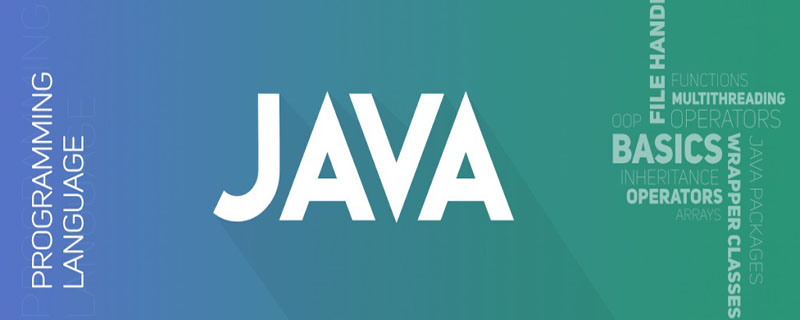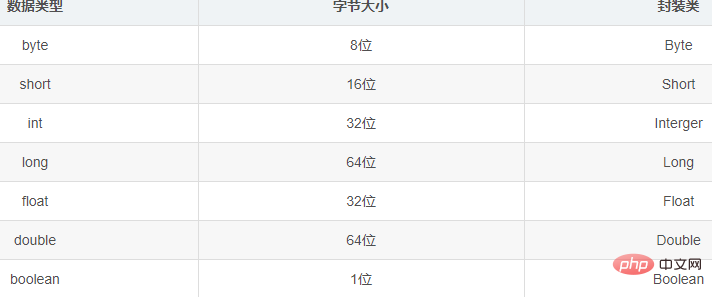The difference between int and integer in java
Nov 30, 2019 pm 05:24 PM
1. Java basic data types and their encapsulation classes

java Data types include basic data types and reference data types. In order to facilitate the processing of basic data types as objects, Java introduces encapsulation classes corresponding to basic data types. For example, the int encapsulation class is Integer.
Online teaching video sharing: java teaching video
2. java automatic unboxing and automatic packing
1. Automatic boxing
Autoboxing is actually converting basic data types into reference data types (objects)
2. Automatic unboxing
Automatic unboxing is actually converting reference data types into basic data types
The code is as follows:
public static void main(String[] args) {
Integer a = 1;//這里就用到了自動(dòng)裝箱;等同于Integer a = new Integer(1);
int b = a - 1;//對(duì)象不能直接進(jìn)行計(jì)算,所以這里有自動(dòng)拆箱的操作,將a對(duì)象轉(zhuǎn)換成基本數(shù)據(jù)類(lèi)型,然后-1
System.out.println(a);
System.out.println(b);
}Print results:
1 0
3. The difference between int and Interger
From the above we can see the difference between int and Interger:
int is the basic data type, and Integer is the reference data type;
## The default value of #int is 0, and the default value of Integer is null; int type directly stores values, and Integer needs to instantiate the object and point to the address of the object. Speaking of this, do you think that’s it? In fact, there are some detailed differences between them: as follows public static void main(String[] args) {
Integer a = new Integer(1);
Integer b = new Integer(1);
int c = 1;
int d = 1;
Integer e = 1;
Integer f = 1;
Integer g = 130;
Integer h = 130;
Integer i = new Integer(130);
int j = 130;
}1: a == b? Nonsense, definitely not equal. The addresses of the two new objects are different. 2: c == d? This is also nonsense, the values ????of basic data types must be equal. 3: The key question now is e == f? g == h? The answer is: e == f; g != h. Why does this happen? Because Integer g = 130 will be compiled into Integer.valueOf(130) when ava is compiled. This can be seen by decompiling the class file. It can be concluded from the Integer source code that the Integer.valueOf() method will cache the Integer between the values ??-128~127, and will not create a new one, so e==f; when the value two is greater than 127 or less than - At 128, a new one will be created, so g != h. The valueOf method of Integer is as follows:
public static Integer valueOf(int i) {
//IntegerCache.low == -128 ;IntegerCache.high == 127
//當(dāng)數(shù)值大于-128小于127時(shí),進(jìn)行緩存;否則重新new一個(gè)。
if (i >= IntegerCache.low && i <= IntegerCache.high)
return IntegerCache.cache[i + (-IntegerCache.low)];
return new Integer(i);
}4: Does c == e, i == j? The answers are all equal. Because when comparing encapsulated classes with basic data types, Java will automatically unbox them and then compare whether the values ??are equal. Summary: 1. They are all encapsulated classes and are all derived from new, so they are definitely not equal. Because the memory addresses of the objects are different. 2. They are all encapsulated classes and are not derived from new. If the value is between -128~127, it is equal, otherwise it is not equal. 3. If the encapsulated class and the basic type are compared, as long as the values ????are equal, they are equal, otherwise they are not equal. Because there will be an automatic unboxing operation when comparing the encapsulated class with the basic data type. 4. They are all basic data types. If the values ??are equal, they are equal; otherwise, they are not equal. For more related tutorials, please visit: The above is the detailed content of The difference between int and integer in java. For more information, please follow other related articles on the PHP Chinese website!

Hot AI Tools

Undress AI Tool
Undress images for free

Undresser.AI Undress
AI-powered app for creating realistic nude photos

AI Clothes Remover
Online AI tool for removing clothes from photos.

Clothoff.io
AI clothes remover

Video Face Swap
Swap faces in any video effortlessly with our completely free AI face swap tool!

Hot Article

Hot Tools

Notepad++7.3.1
Easy-to-use and free code editor

SublimeText3 Chinese version
Chinese version, very easy to use

Zend Studio 13.0.1
Powerful PHP integrated development environment

Dreamweaver CS6
Visual web development tools

SublimeText3 Mac version
God-level code editing software (SublimeText3)

Hot Topics
 How to iterate over a Map in Java?
Jul 13, 2025 am 02:54 AM
How to iterate over a Map in Java?
Jul 13, 2025 am 02:54 AM
There are three common methods to traverse Map in Java: 1. Use entrySet to obtain keys and values at the same time, which is suitable for most scenarios; 2. Use keySet or values to traverse keys or values respectively; 3. Use Java8's forEach to simplify the code structure. entrySet returns a Set set containing all key-value pairs, and each loop gets the Map.Entry object, suitable for frequent access to keys and values; if only keys or values are required, you can call keySet() or values() respectively, or you can get the value through map.get(key) when traversing the keys; Java 8 can use forEach((key,value)->
 Java Optional example
Jul 12, 2025 am 02:55 AM
Java Optional example
Jul 12, 2025 am 02:55 AM
Optional can clearly express intentions and reduce code noise for null judgments. 1. Optional.ofNullable is a common way to deal with null objects. For example, when taking values ??from maps, orElse can be used to provide default values, so that the logic is clearer and concise; 2. Use chain calls maps to achieve nested values ??to safely avoid NPE, and automatically terminate if any link is null and return the default value; 3. Filter can be used for conditional filtering, and subsequent operations will continue to be performed only if the conditions are met, otherwise it will jump directly to orElse, which is suitable for lightweight business judgment; 4. It is not recommended to overuse Optional, such as basic types or simple logic, which will increase complexity, and some scenarios will directly return to nu.
 Comparable vs Comparator in Java
Jul 13, 2025 am 02:31 AM
Comparable vs Comparator in Java
Jul 13, 2025 am 02:31 AM
In Java, Comparable is used to define default sorting rules internally, and Comparator is used to define multiple sorting logic externally. 1.Comparable is an interface implemented by the class itself. It defines the natural order by rewriting the compareTo() method. It is suitable for classes with fixed and most commonly used sorting methods, such as String or Integer. 2. Comparator is an externally defined functional interface, implemented through the compare() method, suitable for situations where multiple sorting methods are required for the same class, the class source code cannot be modified, or the sorting logic is often changed. The difference between the two is that Comparable can only define a sorting logic and needs to modify the class itself, while Compar
 How to fix java.io.NotSerializableException?
Jul 12, 2025 am 03:07 AM
How to fix java.io.NotSerializableException?
Jul 12, 2025 am 03:07 AM
The core workaround for encountering java.io.NotSerializableException is to ensure that all classes that need to be serialized implement the Serializable interface and check the serialization support of nested objects. 1. Add implementsSerializable to the main class; 2. Ensure that the corresponding classes of custom fields in the class also implement Serializable; 3. Use transient to mark fields that do not need to be serialized; 4. Check the non-serialized types in collections or nested objects; 5. Check which class does not implement the interface; 6. Consider replacement design for classes that cannot be modified, such as saving key data or using serializable intermediate structures; 7. Consider modifying
 How to handle character encoding issues in Java?
Jul 13, 2025 am 02:46 AM
How to handle character encoding issues in Java?
Jul 13, 2025 am 02:46 AM
To deal with character encoding problems in Java, the key is to clearly specify the encoding used at each step. 1. Always specify encoding when reading and writing text, use InputStreamReader and OutputStreamWriter and pass in an explicit character set to avoid relying on system default encoding. 2. Make sure both ends are consistent when processing strings on the network boundary, set the correct Content-Type header and explicitly specify the encoding with the library. 3. Use String.getBytes() and newString(byte[]) with caution, and always manually specify StandardCharsets.UTF_8 to avoid data corruption caused by platform differences. In short, by
 JavaScript Data Types: Primitive vs Reference
Jul 13, 2025 am 02:43 AM
JavaScript Data Types: Primitive vs Reference
Jul 13, 2025 am 02:43 AM
JavaScript data types are divided into primitive types and reference types. Primitive types include string, number, boolean, null, undefined, and symbol. The values are immutable and copies are copied when assigning values, so they do not affect each other; reference types such as objects, arrays and functions store memory addresses, and variables pointing to the same object will affect each other. Typeof and instanceof can be used to determine types, but pay attention to the historical issues of typeofnull. Understanding these two types of differences can help write more stable and reliable code.
 Java method references explained
Jul 12, 2025 am 02:59 AM
Java method references explained
Jul 12, 2025 am 02:59 AM
Method reference is a way to simplify the writing of Lambda expressions in Java, making the code more concise. It is not a new syntax, but a shortcut to Lambda expressions introduced by Java 8, suitable for the context of functional interfaces. The core is to use existing methods directly as implementations of functional interfaces. For example, System.out::println is equivalent to s->System.out.println(s). There are four main forms of method reference: 1. Static method reference (ClassName::staticMethodName); 2. Instance method reference (binding to a specific object, instance::methodName); 3.
 What is the 'static' keyword in Java?
Jul 13, 2025 am 02:51 AM
What is the 'static' keyword in Java?
Jul 13, 2025 am 02:51 AM
InJava,thestatickeywordmeansamemberbelongstotheclassitself,nottoinstances.Staticvariablesaresharedacrossallinstancesandaccessedwithoutobjectcreation,usefulforglobaltrackingorconstants.Staticmethodsoperateattheclasslevel,cannotaccessnon-staticmembers,






